Content
- 1 Symptoms and treatment of infectious diseases of pigs with photos
- 2 Infectious diseases of pigs that are not dangerous to humans and their treatment
- 3 Helminthiasis of pigs, dangerous to humans
- 4 Invasive skin diseases in pigs, symptoms and treatment
- 5 Sarcoptic mange
- 6 Non-communicable diseases of pigs
- 7 Conclusion
Pigs are a very profitable economic type of agricultural meat animals. Pigs grow quickly, reproduce quickly, and bear numerous offspring.In the absence of infections and minimal care from their owners, pigs have a high survival rate. Pigs are omnivores, which makes keeping pigs much easier. Pork is one of the most easily digestible types of meat. These qualities make the pig a better choice both for business and as a source of meat for the family. If it were not for the susceptibility of pigs to various diseases, many of which are dangerous to humans.
Infectious diseases of pigs, with the exception of diseases common to several species of mammals, are not dangerous to humans, but cause epizootics among pigs, which is why not only the entire population of domestic pigs in the quarantine area is often destroyed.
Symptoms and treatment of infectious diseases of pigs with photos
Foot and mouth disease in pigs
Pigs are one of the animal species susceptible to this disease. Foot and mouth disease is a highly contagious and acute viral disease that has the ability to spread rapidly. The virus can spread on the wheels of vehicles, personnel shoes, and through meat products.
In pigs, the disease is characterized by short-term fever and the appearance of aphthae on the mucous membrane of the mouth, udder, crown of the hooves and interhoof cleft.
The disease in pigs is caused by one of several serotypes of an RNA virus. All types of foot and mouth disease virus are resistant to the external environment and to the action of disinfectant solutions. The foot and mouth disease virus is neutralized by acids and alkalis.
Symptoms of the disease in pigs
The latent period of the disease can be from 36 hours to 21 days. But these values are quite rare.The usual period of latent progression of the disease is 2–7 days.
In adult pigs, aphthae form on the snout, tongue, crown of the hooves and udder. Epithelial detachment occurs on the tongue. Lameness develops.
Piglets do not develop aphthae, but symptoms of gastroenteritis and intoxication are observed.
Treatment of foot and mouth disease in pigs
Treatment of pigs is carried out with anti-foot and mouth drugs: immunolactone, lactoglobulin and blood serum of convalescents, that is, recovering pigs. The pigs' mouths are washed with antiseptic and astringent preparations. The udders and hooves of pigs are surgically treated, after which antibiotics and painkillers are used. According to indications, a 40% glucose solution, calcium chloride and saline solution, as well as cardiac drugs, can be used intravenously.
Prevention of disease in pigs
Thanks to strict rules that have been preserved since the times of the USSR, foot and mouth disease in the CIS is perceived as an exotic disease that can affect livestock in the UK, and not in Russia. Nevertheless, outbreaks of foot-and-mouth disease in pigs also occur on Russian farms, but only some pigs get sick due to universal vaccination against foot-and-mouth disease. That is, only those pigs whose disease has “broken through” their immunity after vaccination get sick.
If foot and mouth disease occurs in pigs, the farm is placed under strict quarantine; any movement of pigs and production products is prohibited. Sick pigs are isolated and treated. Premises, equipment, protective clothing, and vehicles are disinfected. The manure is disinfected. The corpses of pigs are burned. Quarantine can be lifted 21 days after all animals have recovered and are thoroughly disinfected.
Rabies
A viral disease that is dangerous not only for animals, but also for humans. The disease is transmitted only through a bite. In pigs, the disease occurs in a violent form with pronounced aggressiveness and agitation.
Symptoms of rabies
The duration of the incubation period of the disease in pigs is from 3 weeks to 2 months. Signs of the disease in pigs are similar to those of rabies, which occurs in violent form in carnivores: unsteady gait, excessive salivation, difficulty swallowing. Aggressive pigs attack other animals and humans. Before dying, pigs develop paralysis. The disease lasts 5-6 days.
Prevention of rabies disease
Since rabies is incurable even in humans, all measures are aimed at preventing the disease. In areas unaffected by rabies, pigs are vaccinated. If there are a large number of foxes in the wild near the farm, it is necessary to prevent wild animals from getting to the pigs. Deratization of the area is mandatory, since rats, along with squirrels, are one of the main carriers of rabies.
Swine pox
Smallpox as a disease is common to many animal species, including humans. But it is caused by different types of DNA viruses. This virus only causes disease in pigs and is not dangerous to humans. Pigpox is transmitted by contact of a healthy animal with a sick one, as well as by skin parasites.
Symptoms of swine pox
Different types of animals have different incubation periods for the disease; in pigs it is 2-7 days. When you get smallpox, your body temperature rises to 42°C. Skin and mucous membrane lesions characteristic of smallpox appear.
The course of smallpox is mainly acute and subacute. A chronic form of the disease occurs. Swinepox has several forms: abortive, confluent and hemorrhagic; typical and atypical. The disease is often complicated by secondary infections. In the typical form of the disease, all stages of the development of the disease are observed; in the atypical form, the disease stops at the papules stage.
Confluent pox: pustules coalesce into large, pus-filled blisters. Hemorrhagic smallpox: bleeding into pockmarks and skin. When contracting hemorrhagic confluent pox, the mortality rate of piglets is from 60 to 100%.
In pigs, roseola turns into pustules as the disease develops.
An accurate diagnosis is established through laboratory tests.
Treatment of swine pox
When dealing with smallpox, treatment of pigs is mainly symptomatic. Sick pigs are isolated in dry and warm rooms, provided with free access to water, adding potassium iodide to it. Smallpox crusts are softened with ointments, glycerin or fat. Ulcers are treated with cauterizing agents. Broad-spectrum antibiotics are used to prevent secondary infections.
Prevention of swine pox
When smallpox appears, the farm is quarantined, which is removed only 21 days after the last dead or recovered pig and thorough disinfection.The corpses of pigs with clinical signs of disease are burned whole. Prevention of smallpox is not aimed at protecting the household from the disease, but at preventing the spread of the disease further across the area.
Aujeszky's disease
The disease is also known as pseudorabies. The disease brings significant losses to farms, as it is caused by the porcine herpes virus, although it can also affect other species of mammals. The disease is characterized by encephalomyelitis and pneumonia. Convulsions, fever, and agitation may occur.
Symptoms of the disease
The incubation period of the disease in pigs is 5–10 days. Adult pigs experience fever, lethargy, sneezing, and decreased appetite. The condition of the animals returns to normal after 3–4 days. The central nervous system is extremely rarely affected.
Piglets, especially suckling and weaned ones, suffer from Aujeszky's disease much more severely. They develop central nervous system syndrome. In this case, the incidence in piglets can reach 100%, mortality in 2-week-old piglets from 80% to 100%, in older ones from 40 to 80%. The diagnosis is made on the basis of laboratory tests, differentiating Aujeszky from Teschen's disease, plague, rabies, listeriosis, influenza, edema, and poisoning.
The picture shows a picture of damage to the central nervous system in Aujeszky's disease with a characteristic deflection of the back.
Treatment of the disease
Treatment for the disease has not been developed, although there are attempts to treat it with hyperimmune serum. But it is ineffective. To prevent the development of secondary infections, antibiotics and vitamins are used (to boost immunity).
Disease prevention
When there is a threat of a disease outbreak, susceptible animals are vaccinated according to instructions.In the event of an outbreak of the disease, the farm is quarantined, which is removed provided that a healthy offspring is obtained six months after the cessation of vaccination.
anthrax
One of the most dangerous infectious diseases that affects not only animals, but also people. Active anthrax bacilli are not very stable in external conditions, but the spores can survive practically forever. Due to the weakening of government control over animal burial grounds where animals killed by anthrax were buried, this disease began to reappear on farms. Anthrax can be transmitted even by cutting up a slaughtered, sick animal or by contact with contaminated meat when preparing a dish from it. Provided that an unscrupulous seller sold meat from pigs infected with anthrax.
Symptoms of the disease
The incubation period of the disease is up to 3 days. Most often, the disease progresses very quickly. The fulminant course of the disease, when the animal suddenly falls and dies within a few minutes, is more common in sheep than in pigs, but this form of the disease cannot be excluded. In the acute course of the disease, the pig is sick for 1 to 3 days. In a subacute course, the disease drags on for up to 5–8 days or up to 2–3 months in a chronic course. Rarely, abortive anthrax occurs, in which the pig recovers.
In pigs, the disease occurs with symptoms of sore throat, affecting the tonsils. The neck also swells. Signs are revealed only during post-mortem inspection of the pork carcass. With the intestinal form of anthrax, fever, colic, constipation, followed by diarrhea are observed. In the pulmonary form of the disease, pulmonary edema develops.
The diagnosis is made on the basis of laboratory tests.Anthrax must be distinguished from malignant edema, pasteurellosis, piroplasmosis, enterotoxemia, emkar and bradzot.
Treatment and prevention of the disease
Anthrax is quite treatable if precautions are taken. To treat the disease, gamma globulin, anthrax serum, antibiotics, and local anti-inflammatory therapy are used.
To prevent the disease in disadvantaged areas, all animals are vaccinated twice a year. In the event of an outbreak of the disease, a quarantine is imposed on the farm. Sick pigs are isolated and treated, suspicious animals are immunized and monitored for 10 days. The corpses of dead animals are burned. The affected area is thoroughly disinfected. Quarantine is lifted 15 days after the last recovery or death of the pig.
Listeriosis
A bacterial infection to which wild and domestic animals are susceptible. The infection is a natural focal one, transmitted to pigs from wild rodents.
Symptoms of the disease
Listeriosis has several forms of clinical manifestation. In the nervous form of the disease, body temperature rises to 40 - 41°C. Pigs show loss of interest in food, depression, and lacrimation. After some time, the animals develop diarrhea, coughing, vomiting, moving backwards, and a rash. Death in the nervous form of the disease occurs in 60–100% of cases.
The septic form of the disease occurs in piglets in the first months of life. Signs of the septic form of the disease: cough, blueness of the ears and abdomen, difficulty breathing. In most cases, piglets die within 2 weeks.
The diagnosis is made in the laboratory, differentiating listeriosis from many other diseases whose symptoms are very similar.
Treatment of listeriosis
Treatment of the disease is effective only in the initial stage. Antibiotics of the penicillin and tetracycline groups are prescribed. At the same time, symptomatic treatment of animals is carried out, supporting cardiac activity and improving digestion.
Disease prevention
The main measure to prevent listeriosis is regular deratization, which controls the number of rodents and prevents the introduction of the pathogen. In the event of an outbreak, suspected pigs are isolated and treated. The rest are vaccinated with a dry live vaccine.
Many pig diseases and their symptoms are very similar to each other, making it easy for pig owners to confuse their symptoms.
Infectious diseases of pigs that are not dangerous to humans and their treatment
Although these pig diseases are not common to human diseases, the diseases cause significant economic damage, being easily transmitted from one pig to another and traveling long distances on shoes and car tires.
One of the new and very dangerous diseases for pig farming is African swine fever.
African swine fever
The disease was introduced to the European continent in the second half of the 20th century, causing significant damage to pig production. Since then, ASF has periodically flared up in different places.
The disease is caused by a DNA virus that is transmitted not only through the secretions of sick animals and household items, but also through poorly processed pig products. The virus is perfectly preserved in salted and uncooked smoked pork products.According to one of the official versions of the sensational ASF outbreak in the Nizhny Novgorod region in 2011, the cause of the disease in backyard pigs was feeding the pigs unheated food waste from a nearby military unit.
In addition to table waste, any object that has been in contact with a sick or dead pig from ASF can mechanically transmit the virus: parasites, birds, rodents, people, etc.
Symptoms of the disease
Infection occurs through contact with a sick animal, by air, and also through the conjunctiva and damaged skin. The incubation period of the disease lasts from 2 to 6 days. The course of the disease can be hyperacute, acute or chronic. The chronic course of the disease is less common.
In the case of a hyperacute course, no external signs of the disease are observed, although it actually lasts 2–3 days. But pigs die “out of the blue.”
In the acute course of the disease, which lasts 7–10 days, pigs experience an increase in temperature up to 42 degrees, shortness of breath, coughing, vomiting, and nervous damage to the hind limbs, expressed in paralysis and paresis. Bloody diarrhea is possible, although constipation is more common. Purulent discharge appears from the nose and eyes of sick pigs. The number of leukocytes decreases to 50 – 60%. The gait is shaky, the tail is untwisted, the head is lowered, weakness of the hind legs, loss of interest in the outside world. The pigs are thirsty. Red-violet spots appear on the neck, behind the ears, the inside of the hind legs, and on the stomach, which do not fade when pressed. Pregnant sows abort.
The chronic course of the disease can last from 2 to 10 months.
Depending on the course of the disease, mortality among pigs reaches 50-100%. Surviving pigs become lifelong carriers of the virus.
Disease prevention
ASF must be differentiated from classical swine fever, although there is no difference for the pigs themselves. In both cases they will be killed.
Since ASF is a highly contagious disease of pigs that can wipe out the entire pig population, when cases of ASF appear, pigs are not treated. In a dysfunctional farm, all pigs are destroyed using a bloodless method and burned. Pigs that came into contact with sick people are also destroyed. All waste products are burned, and the ash is buried in pits, mixing it with lime.
A quarantine is declared in the area. Within a radius of 25 km from the outbreak of the disease, all pigs are slaughtered, and the meat is sent for processing into canned food.
Quarantine is lifted only 40 days after the last case of the disease. Breeding pigs is allowed another 40 days after the quarantine is lifted. However, the practice of the same Nizhny Novgorod region shows that after ASF in their area, it is better for private owners not to risk having new pigs at all. Veterinary service workers can play it safe.
Classic swine fever
A highly contagious viral disease of pigs, the causative agent of which is an RNA virus. The disease is characterized by signs of blood poisoning and the appearance of spots on the skin from subcutaneous bleeding in the acute form of the disease. In subacute and chronic forms of the disease, pneumonia and colitis are observed.
Symptoms of the disease
On average, the incubation period of the disease is 5-8 days. Sometimes shorter periods of illness are observed: 3 days, and longer periods of illness: 2-3 weeks. The course of the disease is acute, subacute and chronic.In rare cases, the course of the disease can be lightning fast. CSF has five forms of the disease:
- septic;
- pulmonary;
- nervous;
- intestinal;
- atypical.
Forms appear during different courses of the disease.
| Lightning course of the disease | A sharp increase in temperature to 41-42°C; depression; loss of appetite; vomit; disorders of cardiovascular activity. Death occurs within 3 days |
|---|---|
| Acute course of the disease | Fever occurring at a temperature of 40-41°C; weakness; chills; vomit; constipation followed by bloody diarrhea; severe exhaustion on the 2-3rd day of illness; conjunctivitis; purulent rhinitis; possible nosebleeds; damage to the central nervous system, expressed in impaired coordination of movements; decrease in leukocytes in the blood; bleeding into the skin (plague spots); pregnant women are aborted; before death, body temperature drops to 35°C. The pig dies 7-10 days after the appearance of clinical signs |
| Subacute course of the disease | In the pulmonary form, the respiratory organs are affected, leading to the development of pneumonia; in the intestinal form, there is a perversion of appetite, alternating diarrhea and constipation, and enterocolitis. In both forms, fever occurs periodically; weakness appears; Pig deaths are common. Recovered pigs remain virus carriers for 10 months |
| Chronic course of the disease | Long duration: more than 2 months; severe damage to the gastrointestinal tract; purulent pneumonia and pleurisy; significant developmental delay. Death occurs in 30-60% of cases |
Treatment and prevention of the disease
Diagnosis is made based on clinical signs and laboratory tests. Classical swine fever must be separated from many other diseases, including ASF, Aujeszky's disease, erysipelas, pasteurellosis, salmonellosis and others.
Which no one actually does, which is why, for example, salt poisoning of pigs can be mistaken for plague.
Treatment for the disease has not been developed; sick pigs are slaughtered. They carry out strict control over the purchased new livestock to prevent the penetration of swine fever into a healthy farm. When using slaughterhouse waste in feedlots, the waste is reliably disinfected.
When plague appears, the farm is quarantined and disinfection measures are carried out. Quarantine is lifted 40 days after the last death or slaughter of sick pigs.
Porcine enzootic encephalomyelitis
A simpler name: Taschen disease. The disease causes significant economic damage, as up to 95% of affected pigs die. The disease manifests itself as paralysis and paresis of the limbs, and a general nervous disorder. The causative agent is an RNA virus. The disease is widespread throughout the European continent.
The main way the disease spreads is through the solid feces of sick animals. Moreover, the virus can disappear and appear again, causing another outbreak of the disease. The route of introduction of the virus has not been established. There is an opinion that the disease appears after private owners slaughter virus-carrying pigs in their backyards.Since sanitary requirements for such slaughter are usually not observed, the virus penetrates into the soil, where it can remain active for a long time.
Teschen's disease (enzootic encephalomyelitis of pigs)
Symptoms of the disease
The incubation period for Teschen disease is from 9 to 35 days. The disease is characterized by clear signs of damage to the nervous system, leading to encephalitis.
The disease has 4 types of course.
In the hyperacute course of the disease, a very rapid development of paralysis is observed, in which the pigs can no longer walk and only lie on their sides. Animal death occurs 2 days after the onset of symptoms of the disease.
The acute course of the disease begins with lameness in the hind limbs, which quickly turns into paresis. When moving, the pig's sacrum swings to the sides. Pigs often fall and after several falls they can no longer get up. Animals develop an excited state and increased pain sensitivity of the skin. Trying to stay on their feet, the pigs lean against the support. Appetite preserved. After 1-2 days from the onset of the disease, complete paralysis develops. The animal dies from suffocation as a result of paralysis of the respiratory center.
In the subacute course of the disease, signs of damage to the central nervous system are not so pronounced, but in the chronic course, many pigs recover, but damage to the central nervous system remains: encephalitis, lameness, slowly regressing paralysis. Many pigs die from pneumonia, which develops as a complication of the disease.
When diagnosing, Teschen's disease must be differentiated not only from other infectious diseases, but also from such non-contagious diseases of pigs as A and D-vitaminosis and poisoning, including table salt.
Disease prevention
They prevent the introduction of the virus by forming a pig herd only from safe farms and be sure to quarantine new pigs. When a disease occurs, all pigs are slaughtered and processed into canned food. Quarantine is lifted 40 days after the last death or slaughter of a sick pig and disinfection.
There is no treatment for Teschen's disease.
Helminthiasis of pigs, dangerous to humans
Of all the worms that pigs can be infected with, two are the most dangerous for humans: pork tapeworm or pork tapeworm and trichinella.
Pork tapeworm
A tapeworm whose main host is humans. Tapeworm eggs, along with human feces, are released into the external environment, where they can be eaten by a pig. In the intestines of a pig, larvae emerge from the eggs, some of which penetrate the muscles of the pig and there transform into a finna - a round embryo.
Humans become infected by eating poorly cooked pig meat. If Finns enter the human body, adult worms emerge and continue the reproduction cycle. When tapeworm eggs enter the human body, the finna stage occurs in the human body, which can lead to death.
Trichinosis
Trichinella is a small nematode that develops in the body of a single host. Omnivores and carnivores, including humans, are infected with the parasite. In humans, this occurs when eating poorly cooked pork or bear meat.
Trichinella larvae are very resistant and do not die when meat is lightly salted and smoked. They can survive for a long time in rotting meat, which creates the preconditions for infection of some scavenger with Trichinella.
A simplified scheme for infection with Trichinella from a pig: a pig is an omnivore, therefore, having found a dead mouse, rat, squirrel or other corpse of a predatory or omnivorous animal, the pig will eat carrion. If the corpse was infected with Trichinella, then when it enters the pig's intestines, Trichinella will release up to 2,100 live larvae. The larvae penetrate with the blood into the striated muscles of the pig and pupate there.
Next, they wait in the wings for another animal to eat the pig.
After the slaughter of a sick pig and the consumption of poorly processed meat for human food, Trichinella finna emerges from suspended animation and releases its 2,000 larvae already in the human body. The larvae penetrate human muscles and pupate in the human body. Lethal dose of larvae: 5 pieces per kilogram of human weight.
Disease prevention measures
Treatment for the disease has not been developed. Pigs with trichinosis are slaughtered and disposed of. They carry out deratization and destruction of stray animals near the farm. Unsupervised roaming of pigs throughout the territory is not permitted.
As a measure to prevent illness, it is better for a person not to buy pork in unspecified places.
Treatment of pigs against worms
Invasive skin diseases in pigs, symptoms and treatment
Skin diseases of pigs, and not only pigs, are all contagious, except for skin manifestations of allergies.Any skin disease in pigs is caused either by a fungus or microscopic mites. If these two reasons are absent, then the skin deformation is a symptom of an internal disease.
Mycoses, popularly known as lichen, are fungal diseases to which all mammals are susceptible.
Trichophytosis or “ringworm” in pigs takes the form of round or oblong scaly red spots. Trichophytosis is spread by rodents and skin parasites.
Microsporia is characterized by hair breaking off at a distance of several millimeters above the skin and the presence of dandruff on the surface of the lesion.
In pigs, microsporia usually begins on the ears as orange-brown spots. Gradually, a thick crust forms at the site of infection and the fungus spreads along the back.
The type of fungus is determined in the laboratory, but the treatment for all types of fungi is very similar. Antifungal ointments and medications are used according to the regimen prescribed by the veterinarian.
Another variant of skin infestation in pigs is the scabies mite, which causes sarcoptic mange.
Sarcoptic mange
The disease is caused by a microscopic mite that lives in the epidermis of the skin. The source of the disease is sick animals. The tick can be transmitted mechanically on clothing or equipment, as well as by flies, rodents, and fleas.
In pigs, sarcoptic mange can occur in two forms: in the ears and throughout the body.
2 days after infection, papules appear on the affected areas, bursting when scratched. The skin peels, stubble falls out, crusts, cracks and folds form. Pigs experience severe itching, especially at night. Because of the itching, pigs become nervous, cannot eat, and become exhausted.If treatment measures are not taken, the pig dies a year after infection.
Treatment of the disease
For the treatment of sarcoptic mange, external anti-tick medications and anti-tick injections of Ivomec or Aversect are used according to the instructions. To prevent the disease, ticks are destroyed in the surrounding area.
Non-communicable diseases of pigs
Non-communicable diseases include:
- injuries;
- congenital abnormalities;
- vitamin deficiencies;
- poisoning;
- obstetric and gynecological pathologies;
- internal diseases caused by non-infectious causes.
All these diseases are common to all species of mammals. Due to the similarity of salt poisoning in pigs with very dangerous types of plague, it should be discussed separately.
Salt poisoning of pigs
The disease occurs when a pig is fed too much salt from food waste from cafeterias or when pigs are fed cattle feed.
Symptoms of the disease
Signs of poisoning appear within 12 to 24 hours from the moment the pig eats salt. Poisoning in a pig is characterized by thirst, excessive salivation, muscle tremors, elevated body temperature, and rapid breathing. The gait is unsteady, the pig assumes the pose of a stray dog. There is a stage of excitement. The pupils are dilated, the skin is bluish or red. Excitement gives way to depression. Due to pharyngeal paresis, pigs cannot eat or drink. Vomiting and diarrhea, sometimes with blood, are possible. Pulse weak, frequent. Before dying, pigs go into a coma.
Treatment of the disease
Infusion of a large amount of water through the probe. Intravenous solution of calcium chloride 10% at the rate of 1 mg/kg body weight. Intravenous glucose solution 40%. Intramuscular calcium gluconate 20-30 ml.
Conclusion
After reading a reference book on veterinary medicine, you may be scared to find out how many diseases a domestic pig can suffer from. But the practice of experienced pig breeders shows that in fact pigs are not so susceptible to various diseases, provided that the breeding area is free from these diseases. If the area is under quarantine, then a summer resident who wants to have a pig will be notified by a local veterinarian. Therefore, with the exception of the death of very young piglets for reasons unrelated to infection, pigs demonstrate good survival and high returns on spent feed.
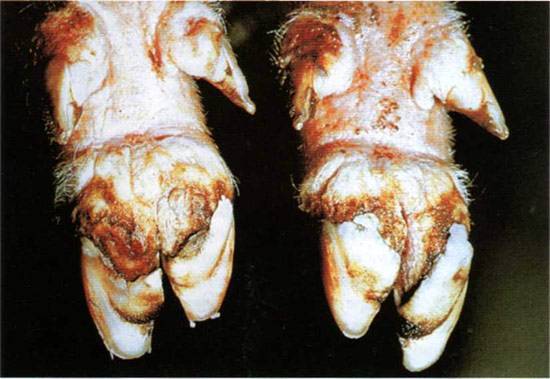
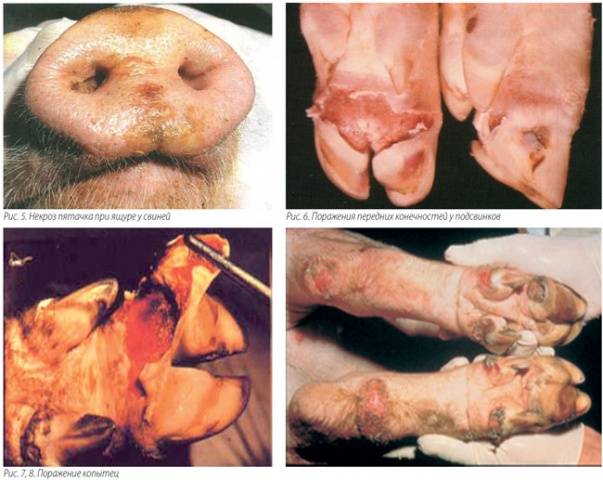
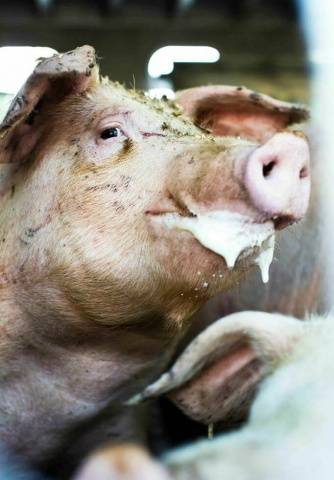
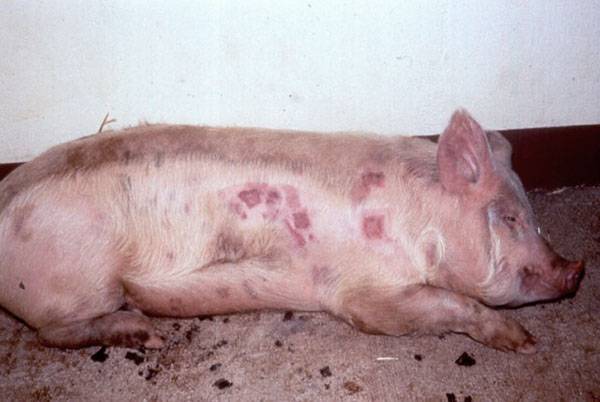
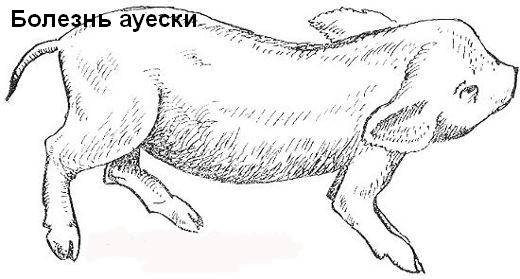
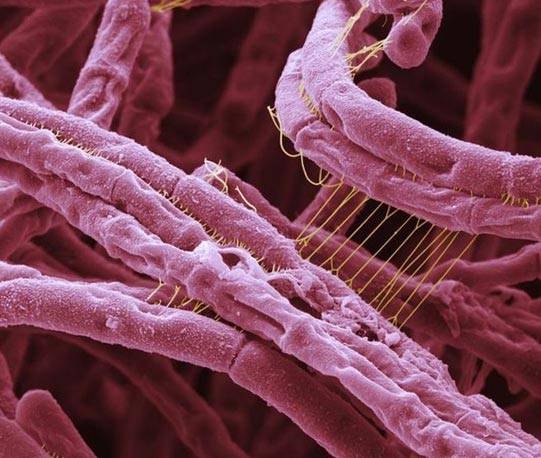
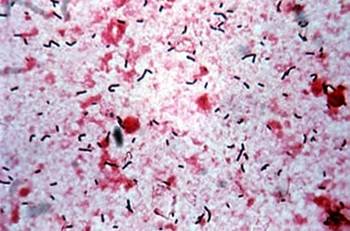
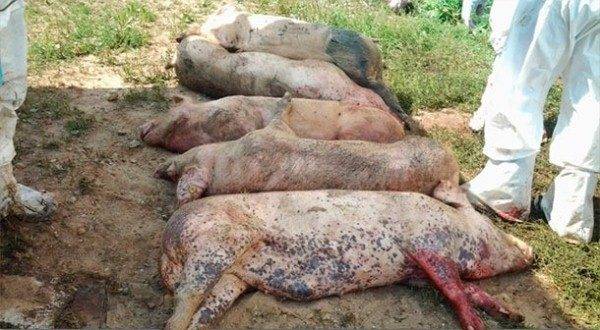
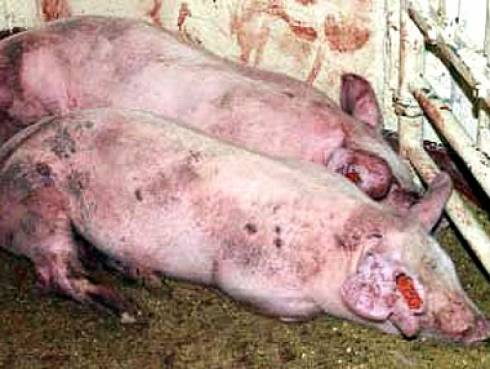
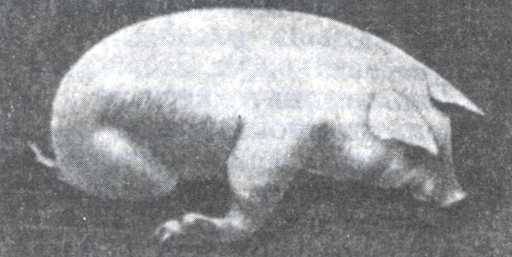
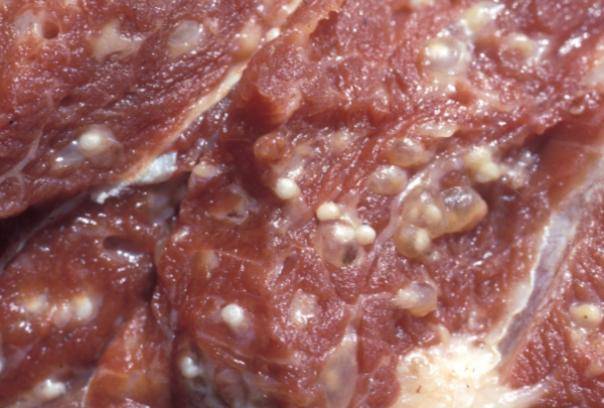
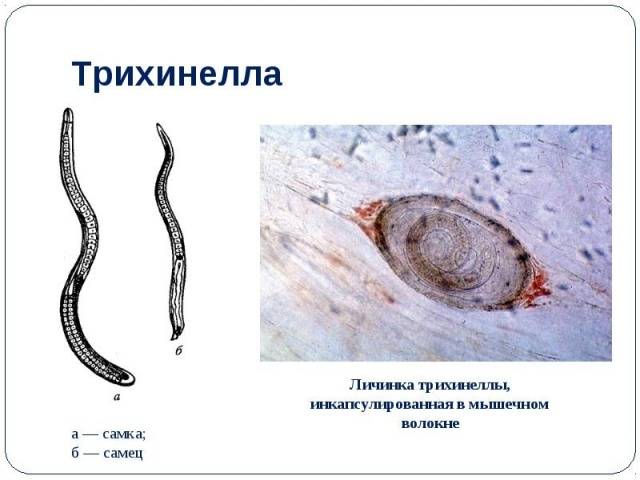
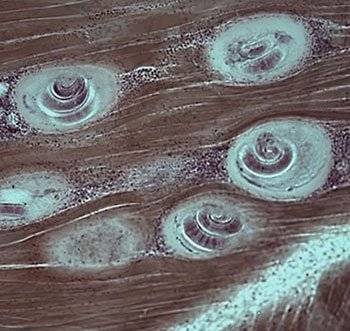
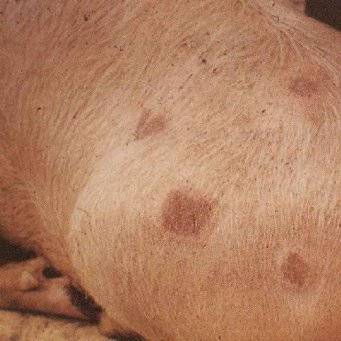
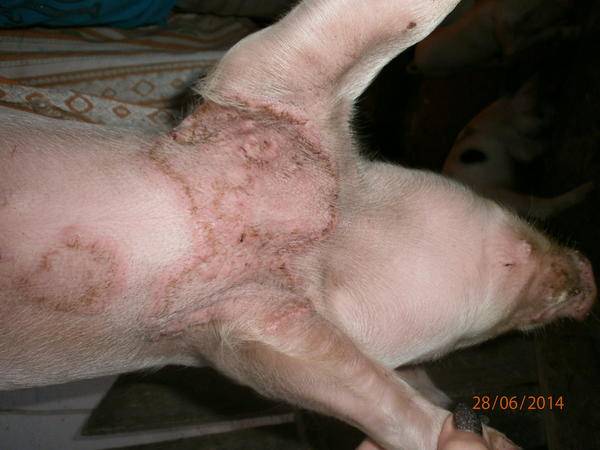
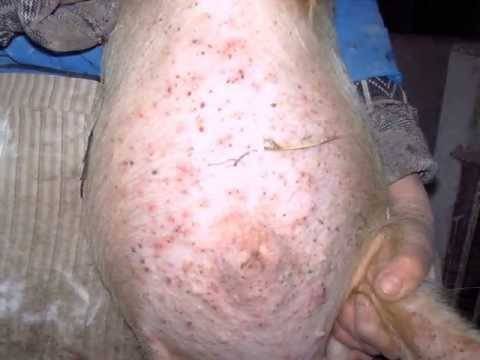
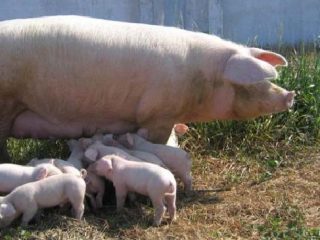
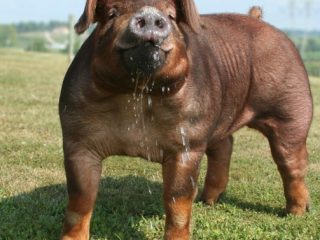
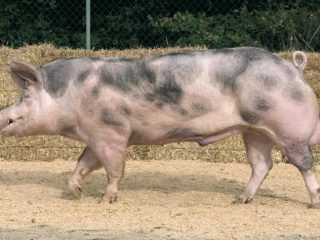
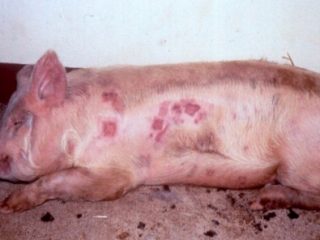
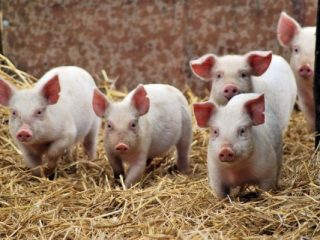
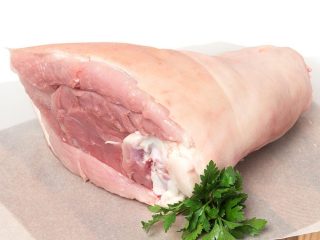
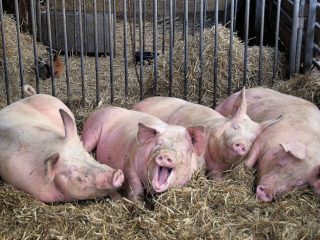

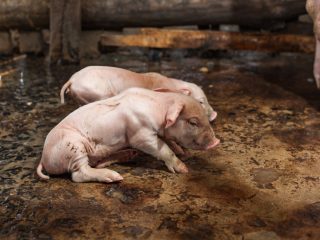
First, redness appeared on the ears, then scabs and dark spots appeared on the body, what is it and how to treat it